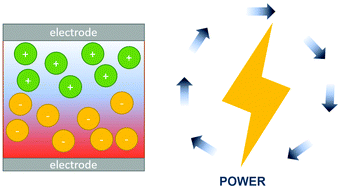Ionic thermoelectrics: principles, materials and applications
Abstract
Abundant heat is generated in household, industry and natural processes, and the majority of the heat is dissipated in the environment as waste heat owing to the low heat utilization efficiency. Hence, harvesting waste heat is of great significance for sustainable development. Among heat-harvesting technologies including organic Rankine cycles, thermo-osmotic energy conversion and thermoelectric generators (TEGs), TEGs that can directly convert heat into electricity are the only feasible technology to harvest low-grade heat that has a temperature below 200 °C and is about 2/3 of the total waste heat. The operational principle of TEGs is the Seebeck effect of electronic thermoelectric (TE) materials such as semiconductors or semimetals. Recently, ionic conductors, such as liquid ionic conductors and gel ionic conductors, emerged as the next-generation TE materials mainly due to their high thermopower. Their thermopower can be higher than that of the electronic TE materials by 2–3 orders of magnitude. In addition, they usually have a low thermal conductivity. Because the charge carriers in ionic conductors are cations and anions, the principles for the ionic thermopower and ionic TE conversion devices are notably different from their electronic counterparts. Very exciting progress has been made in the ionic TE materials and devices. This article provides a review on the most recent discoveries and development of ionic TE materials, including the thermopower mechanism, TE properties, and applications.



 Please wait while we load your content...
Please wait while we load your content...